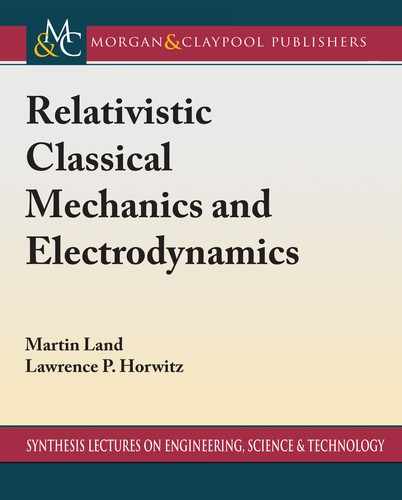
1.4. THE STUECKELBERG–HORWITZ–PIRON (SHP) FRAMEWORK 9
where K D .p eA=c/
2
. Using (1.5) and (1.6) we find
Px
.s/ D i Œx
; K D i
x
;
p
e
c
A
2
D 2
p
e
c
A
(1.7)
and so may perform the Legendre transformation
Z
ds L D
Z
ds
Px
p
K
D
Z
ds
1
4
Px
2
C
e
c
Px A
whose classical limit takes the form of the Fock action (1.1). Although Schwinger found this
representation useful because the scalar parameter s is necessarily independent of x
and Px
,
and so respects Lorentz and gauge invariance, it is known [8] as the Fock-Schwinger “proper
time method.”
DeWitt [11] regarded (1.4) as defining the Green’s function for a Schrodinger equation
i
@
@s
s
.x/ D K
s
.x/ D
p
e
c
A
2
s
.x/ (1.8)
which he used for quantum mechanical calculations in curved spacetime. Similarly, Feyn-
man [12] used (1.8) in his derivation of the path integral for the Klein–Gordon equation. He
regarded the integration (1.3) of the Green’s function with the weight e
im
2
s
as the require-
ment that asymptotic solutions of the Schrödinger equation be stationary eigenstates of the
mass operator i@
. To pick the mass eigenvalue one extends the lower limit of integration in
(1.3) from 0 to 1, and adds the requirement that G.x; x
0
Is/ D 0 for s < 0. Feynman noted
that this requirement, equivalent to imposing retarded causality in chronological time s, leads to
the Feynman propagator
F
.x x
0
/ whose causality properties in t are rather more complex.
Related issues of causality arise in classical relativistic field theory.
1.4 THE STUECKELBERG–HORWITZ–PIRON (SHP)
FRAMEWORK
In 1973, Horwitz and Piron set out to systematically construct a manifestly covariant relativistic
mechanics with interactions. ey observed that the principal difficulties in previous efforts
arose when attempting to define observables that respect a priori constraints associated with the
presumed dynamics. For example, although it may seem natural to choose the proper time of
the motion as the worldline parameterization, Stueckelberg showed that this choice prohibits
a classical account of observed pair phenomena. Worse still, in the Fock–Schwinger formalism
identification of s with the proper time clashes with the formulation of quantum observables,
since
p
dx
2
D
p
Px
2
ds does not commute with x
, rendering the relations (1.5) and (1.6)
difficult to interpret rigorously.
A closely related question is reparameterization invariance. Although one might regard
the parameter as arbitrary, the Fock action (1.1) is clearly not invariant under !
0
D f ./

10 1. CONCEPTUAL APPROACHES TO SPACETIME
because the Lagrangian is not homogeneous of first degree in the velocities. Invariance is often
restored by replacing the quadratic term in the action with a first-order form such as
S D
Z
d
mc
p
Px
2
C
e
c
Px
A
which leads to fixed particle masses
p
D
@L
@ Px
D mc
Px
p
Px
2
C
e
c
A
!
p
e
c
A
2
D m
2
c
2
and restricts the system dynamics to the timelike region by imposing Px
2
< 0.
Although the Fock action permits mass exchange, the mass of individual particles is fixed
for interactions governed by Stueckelberg’s force law (1.2) when G
D 0. Similarly, in the Fock–
Schwinger formalism (1.7) shows that Px
2
D 4K and thus corresponds to a classical constant
of the motion. us, fixed mass is demoted from the status of a priori constraint to that of a
posteriori conservation law for appropriate interactions.
Rejecting such a priori restrictions, Horwitz and Piron postulate that classical particles
and quantum states can be described in an unconstrained 8D phase space
x D
.
ct; x
/
p D
E
c
; p
with canonical equations
Px
D
dx
d
D
@K
@p
Pp
D
dp
d
D
@K
@x
;
where K is a scalar function that determines the system dynamics and its conservation laws. is
framework is seen to include Newtonian mechanics by imposing the restrictions
t D K D H.x; p/ E
which leads to
dx
i
dt
D
@H
@p
i
dp
i
dt
D
@H
@x
i
dE
dt
D
@H
@t
;
where i D 1; 2; 3.
To describe a free relativistic particle one may write
K D
p
2
2M
! Px
D
p
M
and Pp
D 0
so that dt=d D E=M c
2
and d x=dt D pc
2
=E. In particular, for a timelike particle,
Px
2
D
p
2
M
2
D
m
2
c
2
M
2
D constant;
..................Content has been hidden....................
You can't read the all page of ebook, please click here login for view all page.
